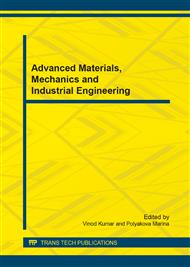p.160
p.164
p.169
p.174
p.181
p.189
p.194
p.198
p.202
Sensitivity Analysis and Optimization of Machining Parameters Based on Surface Roughness Prediction for AA6061
Abstract:
Surface roughness is strongly affected by machining parameters. In the past few decades, many researchers have established the relationship between the surface roughness and machining parameters, but less attention has been paid to tool shape and geometry. In addition, the number of tool flutes was ignored, which affects in vibrations and machining system. Therefore, this study first-time includes the tool flutes in addition to cutting speed, depth of cut and feed rate as independent variables. Firstly, a set of machining experiments were conducted using AA6061 as a work piece material to provide original data. Response Surface Model (RSM) adopted to establish the relationship model of surface roughness and machining parameters using Minitab 16. Based on analysis of variance (ANOVA), the results show cutter flutes has higher significant followed by feed rate, depth of cut and cutting speed which has less significant. Finally, machining parameters were optimized to desired surface roughness, and optimization prediction error has limited values between-0.02 and 0.02μm.
Info:
Periodical:
Pages:
181-188
Citation:
Online since:
July 2014
Authors:
Price:
Сopyright:
© 2014 Trans Tech Publications Ltd. All Rights Reserved
Share:
Citation:


